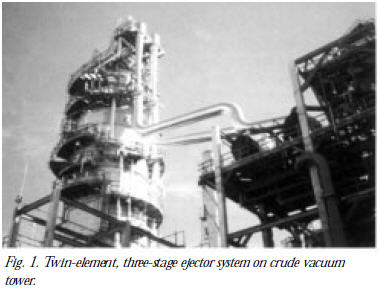
Troubleshooting crude vacuum tower overhead ejector systems
Routinely surveying tower overhead vacuum systems can improve performance and product quality. These vacuum systems normally provide reliable and consistent operation. However, process conditions, supplied utilities, corrosion, erosion and fouling all have an impact on ejector system performance.
Refinery vacuum distillation towers use ejector systems to maintain tower top pressure and remove overhead gases (Fig. 1). However, as with virtually all refinery equipment, performance may be affected by a number of variables. These variables may act independently or oncurrently. It is important to understand basic operating principles of vacuum systems and how performance is affected by:
• Utilities
• Corrosion and erosion
• Fouling
• Process conditions.

Reputable vacuum-system suppliers have service engineers that will come to a refinery to survey the system and troubleshoot performance or offer suggestions for improvement. A skilled vacuum-system engineer may be needed to diagnose and remedy system problems.
UTILITIES
When a vacuum system is initially designed, utilities are established and the most extreme conditions are usually used for the design basis. Once operating, actual utility supply conditions can be different than those set at the design stage and vary occasionally. Important utilities for ejector systems are motive steam and cooling water. Motive steam pressure, quality and temperature are critical variables. Flowrate and inlet temperature are important for cooling water.
Motive steam conditions. These are very important and have a direct impact on an ejector’s operation. If motive steam supply pressure falls below design, then the nozzle will pass less steam. When this happens, the ejector is not provided with enough energy to compress the suction load to the design discharge pressure. The same problem occurs when the supply motive steam temperature rises above its design value. Result: Increased specific volume and, therefore, less steam passes through the nozzle.
For details.....